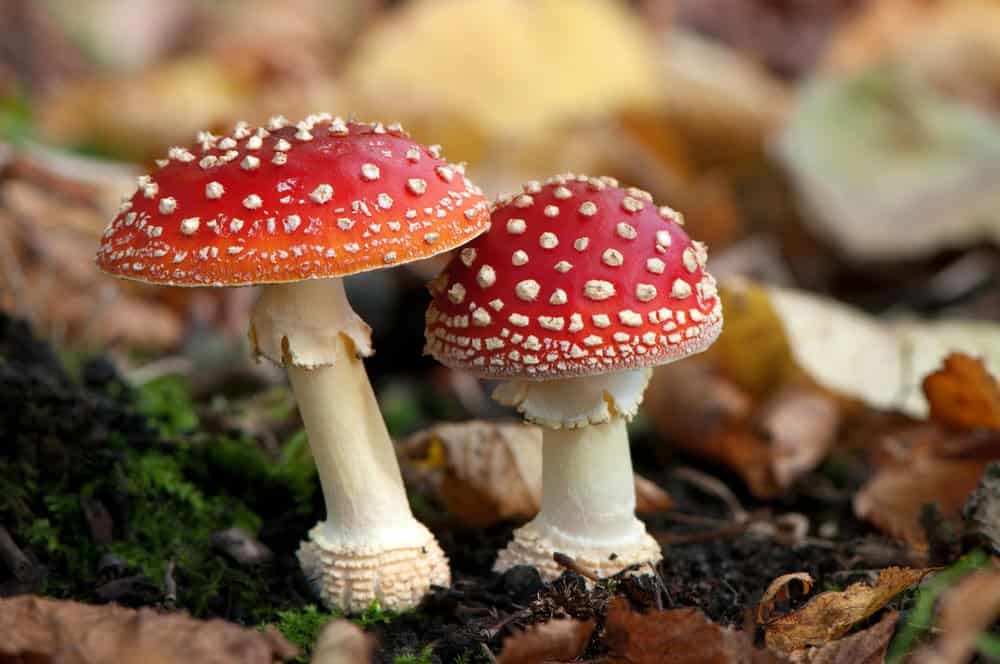Table of Contents
If you suspect mushroom poisoning, don’t wait for symptoms to develop. Take the patient to the medical center immediately. If you live in the USA, call Poison Control at 1-800-222-1222, you will reach one of their 55 centers. They have specialists who can guide you. If you want information on mushroom toxicity keep reading.
What happens if you eat a Poisonous Mushroom?
About 70% of natural poisoning cases are from poisonous wild mushroom ingestion and could end in death.
Most wild mushroom poisoning causes stomach pain and vomiting. So, if you or anyone you know has eaten a mushroom that they think could be poisonous. Act fast.
The mushrooms that act slowly are more dangerous than those with fast action. Therefore, you should not wait for symptoms to develop.
Different kinds of Mushroom Poisoning
Twelve types of poisons exist in mushrooms. A poisonous wild mushroom can have one or more of them. The effect varies from mild to lethal.
Based on the type of poison and amount ingested, symptoms will vary. Experts group the problems based on the symptoms:
- Early Gastrointestinal (GI) Symptoms
- Early Nervous Problems
- Early Kidney Failure
- Delayed Gastrointestinal Symptoms
- Delayed Kidney Failure
- Miscellaneous
Early Gastrointestinal Symptoms
The symptoms will appear within 15 minutes to 4 hours. They can be abdominal pain, vomiting, and diarrhea. Once the poison is out of the body, the effects stop. Supportive treatment is often enough. Give lots of fluids and electrolytes for people who have vomiting and diarrhea.
The toxins that cause these are:
- Muscarine: You will find this toxin in Inocybe spp., Clitocybe dealbata, and Boletus. Symptoms start within 15-30 minutes of wild mushroom poisoning. Patients can recover within 24 hours in mild cases. Besides stomach problems, you can see wheezing, breathing problems, and bradycardia. In mild cases, people recover in 12 hours. Severe cases can cause death due to breathing problems.
- Isoxazole Derivatives: Muscimol, and Ibotenic acid, are examples. Many Amanita species and Tricholoma muscarinic have these poisons. Symptoms appear between half an hour to 2 hours of ingesting mushrooms. Besides stomach problems, people will also show effects on the nervous system. They are drowsy, confused, and delusional. People can go into a coma that lasts for 24 hours.
- Gyromitrin: This toxin is in many Gyromitra, Helvella, Cudonia, and Verpa species. Even morels will have this toxin if it is raw or undercooked. Besides stomach problems, this mushroom gives people headaches. In severe cases, it causes renal and liver failure and death. It is also cancer-causing.
- Chlorophyllum molybdites are the most common mushroom poisoning in the USA. These are the small brown mushrooms that grow in the laws. So, babies and pets are the ones who suffer the most. Symptoms are bloody diarrhea, vomiting, and abdominal pain.
Early Nervous Problems
Recreational use of hallucinogenic mushrooms causes these symptoms. The responsible toxins are psilocybin and psilocin. You will find them in Psilocybe species. And,in some members of Gymnopilus, Mycena, Pluteus, Conocybe, and Inocybe.
The symptoms appear in 15-30 minutes of ingesting wild mushrooms. Effects last for 4-6 hours. People experience heightened imagination and color perception, anxiety, euphoria, and hallucinations. Do not upset people suffering from this toxin. It can trigger extreme reactions. Sometimes vomiting and fever occur. Death is rare but does occur if children and babies eat them.
Early Kidney Failure
Amanita smithiana, A. proxima, and A. pseudoporphyria cause immediate kidney damage. The symptoms start between 4-11 hours after ingesting wild poisonous mushrooms. People experience cramps, sweating, chills, disorientation, renal failure, thirst, and problems urinating. We don’t know for sure which toxin is responsible. It could be allenic norleucine or chlorocrotylglycine.
Delayed Gastrointestinal Symptoms
Amanita poisoning symptoms appear 6 to 24 hours after eating mushrooms and are very dangerous. It is because at this time the toxins have time to spread in all organs.
The initial symptoms are vomiting, blood in diarrhea, and severe stomach pains. Even though people recover after a day or two, the damage is done. It causes severe kidney and liver failure. People can bleed to death. The lucky ones survive only if they get liver transplantation in time!
There is no known medicine for amatoxin poisoning. If you suspect a mushroom could have amanitin, rush the patient to a hospital. Removing the toxin from the body is the only way to limit amanita poisoning damage.
Mushrooms such as members of Amanita, Gyromitra, and Cortinarius can cause these problems.
Delayed Kidney Failure
Like the delayed GI, late kidney problem is more serious than early symptoms. It happens due to orellanine.
Orellanine is a mushroom poison, you will find in Cortinarius orellanus. Some other members of the Cortinarius have it too. The problem starts 36 hours to three weeks after eating mushrooms.
Symptoms are vomiting, nausea, severe thirst, frequent urination, headache, chills, shivering, convulsions, and kidney failure. Death can occur in 15% of the cases.
Only supportive treatment is available for this problem. If the damage to the kidney is not irreversible, people could recover within four weeks.
Miscellaneous Problems
Many other wild poisonous mushrooms cause vomiting, cramps, and diarrhea. Mushrooms causing them are
- Paxillus involutus
- Clitocybe acromelalga
- Omphalotus spp
Rate of Mushroom Poisoning
In the USA, in 2018, about 6300 people fell ill after eating wild poisonous mushrooms.
Worldwide, 100 people die from wild mushroom poisoning.
Of the thousands of mushrooms that exist, about 100 species will make people ill. And 15-16 mushrooms are poisonous enough to kill.
The death cap or Amanita phalloides causes 90% of the deaths due to mushroom poisoning. People pick it, mistaking it for its close relative Amanita velosa, which is edible. In 2018, the death cap caused 76 cases of poisoning in the USA, but luckily no deaths. The death cap mushroom is spreading rapidly in North America and with it the cases of poisoning.
Causes of Mushroom Poisoning
In most cases, mushroom toxicity occurs due to ingestion. But it can occur from spores and touching too.
Eating
People collect mushrooms to eat as food. About 95% of the poisoning happens, because people have misidentified the mushrooms. Recreational use of mushrooms causes less than 5% of the cases of poisoning.
Even edible species lead to mushroom toxicity. The problem is that some edible mushrooms become toxic based on the tree or area they grow on.
Mushroom toxicity persists even after cooking and processing. Except in shiitake mushrooms. These cause poisoning only when they are raw; there is no danger if you cook them well. The result is a rash that can last for ten days.
Spores
It is possible to get poisoned by mushroom spores of puffballs. Lycoperdon perlatum grows worldwide and produces profuse spores. It leads to respiratory problems. Most patients recover within 1-4 weeks of treatment. So far, we know of only three cases of death due to this mushroom.
When you expose people to mushroom spores for a long term, they can also develop lung problems. Lung inflammation can become chronic. We know this happens due to shiitake spores.
So, this is an occupational risk. And people working in mushroom production should keep it in mind.
Touch
Many of the toxins can be absorbed by the skin. If you know that you have picked or handled a poisonous mushroom, be on the safer side- and wash your hands. Otherwise, you could develop mild symptoms. Those who handle many mushrooms, like researchers, should take precautions. There are reports of problems due to handling Chlorophyllum molybdites and Amanita muscaria.
Mushroom Poisoning in Children
Nearly half the cases of wild mushroom poisoning happen in children below six years.
Children, especially toddlers in the “grazing stage”, will eat anything they find. Chlorophyllum molybdites, which grow in lawns, are the usual culprit. It causes stomach pains and blood spotting in feces, but death is rare.
Mushroom Poisoning in Pets
Pets are more at risk from mushroom toxins than people. But it is clinically difficult to prove mushroom poisoning in them. And cases go undocumented. You will find dogs, cats, and even horses have wild mushroom poisoning.
Some of the mushroom poisoning pets can suffer are:
- Amanitin in wild poisonous mushrooms causes the most problems in pets and can kill them.
- Muscarine poisoning is common in dogs.
- Isoxazole poisoning puts cats and dogs into a coma, but if they come out of it, they can recover completely in a week.
Clorophyllum molybdites, are again a major problem, causing mushroom poisoning in pets.
Preventing Wild Mushroom Poisoning
If you have young children or pets, check your lawns and grounds for wild poisonous mushrooms regularly. And remove them to prevent mushroom poisoning.
There are no home tests to confirm if mushrooms are toxic.
But there could be one for amatoxin soon on the market. The Amatoxtest. Beware that a negative test for Amatoxtest doesn’t mean the mushroom is edible. There many other toxins in mushrooms. It only means the mushroom has no amatoxin.
The only way, to be sure, a mushroom is edible is to correctly identify it.
This new test could also diagnose mushroom poisoning at point-of-care, easily and fast. It identified 92.3% of amatoxin cases accurately. You can use this test for urine, vomit, and mushroom extract. The tests with dogs are less reliable. The Amatotext is not yet FDA approved.
Be Safe
Foraging for wild mushrooms is growing popular around the world. But, do not eat wild mushrooms, if you are not sure. Buy them. Learn to identify them from experts. And always take a book with color pictures, descriptions, and locations to the field. Familiarize yourself with poisonous look-alikes that exist in the area. At the least, you can admire them from afar. There is nothing woodsier and more bountiful than a clump of mushrooms.

